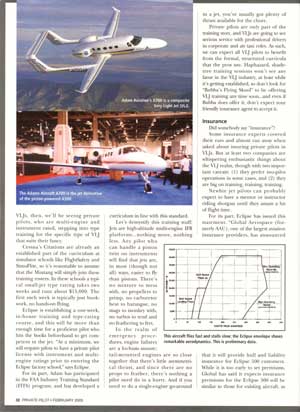| |

Joining the Jet Set
by Ed Stephens Jr.
Private Pilot magazine, February, 2005
(page 3)
Training
In order to serve as pilot in command of a jet-powered airplane, the FAA
requires that a pilot is type rated in it (FAR 61.31(a)(2)). For VJLs, then,
weíll be seeing private pilots, who are multi-engine and instrument rated,
stepping into type training for the specific type of VLJ that suits their
fancy.
Cessnaís Citations are already an established part of the curriculum at
simulator schools like FlightSafety and SimuFlite, so itís reasonable to
assume that the Mustang will simply join these training rosters. In these
schools a typical small jet type rating takes two weeks and runs about
$15,000. The first such week is typically just book work, no hands-on
flying.
Eclipse is establishing a one week, in-house training and type rating
course, and this will be more than enough time for a proficient pilot who
hits the books before hand to get competent in the jet. "At a minimum, we
will require pilots to have a private pilot license with instrument and
multiengine ratings prior to entering the Eclipse factory school," says
Eclipse.
For its part, Adam has participated in the FAA Industry Training Standard
(FITS) program, and has developed a curriculum in lines with this standard.
Letís demystify this training stuff: Jets are high-altitude multi-engine
IFR platforms....nothing more, nothing less. Any pilot who can handle a
piston twin on instruments will find that jets are, in most (though not all)
ways, easier to fly than pistons. Thereís no mixture to mess with, no
propellers to primp, no carburetor heat to harangue, no mags to monkey with,
no turbos to tend, and no feathering to fret.
In the realm of emergency procedures, engine failures are a ho-hum
snooze; tail mounted engines are so close together that thereís little
asymmetrical thrust, and, since there are no props to feather, thereís
nothing a pilot need do in a hurry. And if you need to do a single engine
go-around in a jet, youíve got plenty of thrust available for the chore.
Private Pilots are only part of the training story, and VLJs are going to
see serious service with professional drivers in air taxi roles. As such, we
can expect all VLJ pilots to benefit from the formal, structured curricula
that the pros use. Haphazard, shade-tree training sessions wonít see any
favor in the VLJ industry, at least while itís getting established, so donít
look for "Bubbaís Flying Skool" to be offering VLJ training any time
soon....and even if Bubba does offer it, donít expect your friendly
insurance agent to accept it.
Insurance
Did somebody say "insurance"?
Some insurance experts covered their ears and almost ran away when asked
about insuring private pilots in VLJs. But at least two companies are
whispering enthusiastic things about the VLJ realm, though with two
important caveats: (1) They prefer two-pilot operations in some cases, and
(2) They are big on training, training, training.
Newbie jet pilots can probably expect to have a mentor or instructor
riding shotgun until they amass a bit of flight time.
For its part, Eclipse has issued this statement: " Global Aerospace
(formerly AAU), one of the largest aviation insurance providers, has
announced that it will provide hull and liability insurance for Eclipse 500
customers. While it is too early to set premiums, Global has said it expects
insurance premiums for the Eclipse 500 will be similar to those for existing
aircraft, as long as customers successfully complete Eclipseís training
programs."
Jets are fundamentally safer than anything else in the air, so the
prognosis for insurance is excellent, but you have to play the game the way
your insurance company wants it played. They will select which schools are
approved for training, and they will demand recurrent training at approved
schools as well. Thatís the way it works today, so itís really no change.
Money, money, money
Most pilots canít afford to buy a million dollar jet, but that doesnít
mean that most pilots canít afford to fly them. This is the age of
fractional ownership, shared ownership, and all manner of leasing schemes,
rental arrangements, clubs, and partnerships that spread the cost of an
aircraft over the broadest possible number of users.
Meanwhile, in terms of new IFR iron, a million bucks isnít much these
days. An equipped Beech Baron weighs in at about $1.15 million. A King Air
90 runs about $3 million.
Revolution? Yes.
Of course, the word "revolution" has always been used promiscuously in
aviation, and for decades weíve been told that every suburban driveway would
have a helicopter in it, or that swarms of "personal aircraft" were going to
alleviate the congestion on Interstates. Humbug.
But the VLJ is a genuine revolution. As Donald Burr, of POGO, said, "VLJ
is a home run...I canít see why this isnít visible to people."
Well, it is not visible to some people because general aviation has a
small but vocal clique of carping curmudgeons, who will always insist that
anything invented after 1932, or that costs more than a Ford Pinto, is just
no darned good. But for everyone else, especially those with an interest in
solid IFR flying, the jet age is about to arrive at the local airport. And
as the years go by, used VLJs will start filtering down to ever more
accessible levels as used aircraft roll onto the market. Thatís just how it
works.
So, bottom line: Revolution, yes. Freebie, no....this is, after all,
aviation.
<prior
page>
<back
to aviation page>
<PDF
version (3.2 mb) >
©
2005 Ed Stephens Jr.
|
|